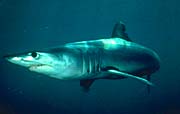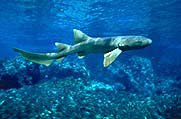
Overview
Introduction
to Sharks
Tagging and Migration
How Do Sharks Migrate?
What Factors Cause Shark Migration?
Shark Distribution
Migration Characteristics of Three Specific Sharks in the
Northern Atlantic Ocean
What Factors Affect the Success of Shark Migration?
and Water Temperature
What Does Tagging Have To Do With Migration?
Workbook
Activities
for Classroom
Shark Tagging Learning Activity
Migration Characteristics of Three Specific Sharks in the Northern Atlantic Ocean Many sharks have interesting migration patterns which have been discovered through tagging. Data has been collected on three sharks in the North Atlantic ocean along the eastern coast of the United States and in the Gulf of Mexico by the National Marine Fisheries Service. These include the shortfin mako, the nurse shark, and the sandbar shark.
 Shortfin Mako sharks also demonstrate migratory behaviors. Shortfin mako sharks have a
fairly narrow preferred temperature range of approximately 17°-22°C (62.6°
-71.60°F). The shortfin mako is probably the most graceful of all sharks. It is
beautifully proportioned, fast, strikingly colored, a spectacular game fish, and
one of the meanest-looking animals on earth. The shortfin mako is one of the so-called
"supersharks." It is steely blue in color with a long pointed snout and curved,
dagger-like teeth. It is powerful, aggressive, and tremendously strong. It is
believed to be the fastest of all the sharks and definitely holds the record for
both long distance travel and for spectacular leaps out of the water. The
shortfin mako has even been known to attack boats, particularly if it has been
hooked by a fisherman. They are distributed world-wide throughout the tropical
and temperate zones of the world's oceans, and is commonly found well off-shore
in deeper waters. Shortfin makos migrate seasonally and have been studied
heavily in the North Atlantic. From June to October shortfin makos are found
between Cape Cod and Cape Hatteras, with a large number being found off southern
New Jersey and New York in the month of June. Here, water temperatures are much
cooler than in the south, and some may move even further north as high as the
Grand Banks. This entire area -- from Cape Cod to Cape Hatteras -- may be the
primary feeding grounds for a large part of the juvenile population of shortfin
mako sharks in the North Atlantic. During late fall and early winter,
November-December, shortfin makos move south from the area between Cape Hatteras ad the
Grand Banks to offshore wintering grounds in the Gulf Stream and the Sargasso
Sea.
Shortfin Mako sharks also demonstrate migratory behaviors. Shortfin mako sharks have a
fairly narrow preferred temperature range of approximately 17°-22°C (62.6°
-71.60°F). The shortfin mako is probably the most graceful of all sharks. It is
beautifully proportioned, fast, strikingly colored, a spectacular game fish, and
one of the meanest-looking animals on earth. The shortfin mako is one of the so-called
"supersharks." It is steely blue in color with a long pointed snout and curved,
dagger-like teeth. It is powerful, aggressive, and tremendously strong. It is
believed to be the fastest of all the sharks and definitely holds the record for
both long distance travel and for spectacular leaps out of the water. The
shortfin mako has even been known to attack boats, particularly if it has been
hooked by a fisherman. They are distributed world-wide throughout the tropical
and temperate zones of the world's oceans, and is commonly found well off-shore
in deeper waters. Shortfin makos migrate seasonally and have been studied
heavily in the North Atlantic. From June to October shortfin makos are found
between Cape Cod and Cape Hatteras, with a large number being found off southern
New Jersey and New York in the month of June. Here, water temperatures are much
cooler than in the south, and some may move even further north as high as the
Grand Banks. This entire area -- from Cape Cod to Cape Hatteras -- may be the
primary feeding grounds for a large part of the juvenile population of shortfin
mako sharks in the North Atlantic. During late fall and early winter,
November-December, shortfin makos move south from the area between Cape Hatteras ad the
Grand Banks to offshore wintering grounds in the Gulf Stream and the Sargasso
Sea.
 Nurse sharks are believed to be non-migratory, but they pose a puzzling problem.
They are common in the tropical waters of the Western Atlantic, are frequently
found in aquariums and easily kept in captivity. They prefer water temperatures
between 20°-30°C (68°-86° F). Nurse sharks hardly move at all during the
daytime, and researchers believe that they inhabit one location for much of their
lives. They can frequently be found sitting motionless, often piled on top of
one another, while resting on the ocean floor. They may also be found in caves
or under coral reefs. They are nocturnal hunters, foraging at night, and tagged
individuals have been identified returning repeatedly to the same caves or
resting sites at the end of each night's hunting.
Nurse sharks are believed to be non-migratory, but they pose a puzzling problem.
They are common in the tropical waters of the Western Atlantic, are frequently
found in aquariums and easily kept in captivity. They prefer water temperatures
between 20°-30°C (68°-86° F). Nurse sharks hardly move at all during the
daytime, and researchers believe that they inhabit one location for much of their
lives. They can frequently be found sitting motionless, often piled on top of
one another, while resting on the ocean floor. They may also be found in caves
or under coral reefs. They are nocturnal hunters, foraging at night, and tagged
individuals have been identified returning repeatedly to the same caves or
resting sites at the end of each night's hunting.
Nurse sharks prefer water temperatures between 20°-30°C(68°-86° F). Since they are prefer warm temperatures and feed on non-migratory animals such as spiny lobsters, small squid, and mollusks, nurse sharks stay in the same tropical locations all their lives. One of the mysteries of migration is that nurse sharks are occasionally found in New England in the summer, but not in the winter when the water temperature drops well below 20°C (68°F). Why are nurse sharks found at all in a region where water temperatures clearly drop below their range? Do some nurse sharks migrate? If so, where do they go? Do they hibernate like bears by slowing down their metabolism (nurse sharks clearly eat less when the water temperature is cold, feeding only once every two weeks or so) ? No one knows for certain where they are in the cold months of the year in New England.
 Thanks to Stewart Springer's research, we know a great deal of exact information
about the migration and other characteristics of the sandbar shark. In addition
to studying the records of commercial fishing operations, Springer assembled data
over twenty-five years and examined several thousand sandbar sharks. Its
distribution changes with the seasons, unlike the nurse shark. Springer
discovered sandbar sharks have a very distinct migratory pattern coupled with
somewhat unusual behavior, almost a migration within a migration. Sandbar
sharks have a preferred temperature range of approximately 15°-30° C (59°-86° F).
During the summer the sandbar shark can generally be found from around Cape Cod,
Massachusetts to West Palm Beach, Florida. In the winter it is generally found
only in the warmer waters near the Carolinas, the southern tip of Florida and on
down into the Gulf of Mexico. In March to early August, when the females are
ready to give birth, the sexes separate. The nursery grounds of the North
Atlantic population are in the shallow waters of the East Coast of the United
States, on the continental shelf from Cape Cod to Cape Kennedy. When the young
are about to be born, the males move to deeper waters, leaving the females in
shallow estuaries or "pupping grounds." This is possibly due to the presence of
bull sharks in this area at the same time and because the pups are so small that
they would be eaten or cannibalized by the adult male sandbar sharks. The
newborn pups stay in the nursery areas from June until September, when the
weather turns cool and they are large enough to move off-shore into deeper water.
Thanks to Stewart Springer's research, we know a great deal of exact information
about the migration and other characteristics of the sandbar shark. In addition
to studying the records of commercial fishing operations, Springer assembled data
over twenty-five years and examined several thousand sandbar sharks. Its
distribution changes with the seasons, unlike the nurse shark. Springer
discovered sandbar sharks have a very distinct migratory pattern coupled with
somewhat unusual behavior, almost a migration within a migration. Sandbar
sharks have a preferred temperature range of approximately 15°-30° C (59°-86° F).
During the summer the sandbar shark can generally be found from around Cape Cod,
Massachusetts to West Palm Beach, Florida. In the winter it is generally found
only in the warmer waters near the Carolinas, the southern tip of Florida and on
down into the Gulf of Mexico. In March to early August, when the females are
ready to give birth, the sexes separate. The nursery grounds of the North
Atlantic population are in the shallow waters of the East Coast of the United
States, on the continental shelf from Cape Cod to Cape Kennedy. When the young
are about to be born, the males move to deeper waters, leaving the females in
shallow estuaries or "pupping grounds." This is possibly due to the presence of
bull sharks in this area at the same time and because the pups are so small that
they would be eaten or cannibalized by the adult male sandbar sharks. The
newborn pups stay in the nursery areas from June until September, when the
weather turns cool and they are large enough to move off-shore into deeper water.
Copyright © Ocean Of Know